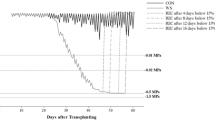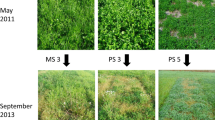Summary
Three double-cut red clover (Trifolium pratense L.) varieties: Prosper I, Florex, and Tristan each with two different seedlots were space-planted in a field. The total number of plants established for each seedlot was about 900. In the seedling year, plants were classified into five growth types according to rosette development and flower production. In the fall of the third year 14% of the rosette-forming, non-flowering Type 1 plants were alive; 8–11% of the intermediate types survived; and only 2% of the nonrosette-forming, profusely flowering Type 5 plants remained growing. The non-flowering class (Types 1 and 2) persisted better than the flowering class (Types 3, 4, and 5). This difference in persistence was similar for all three varieties regardless of seed source. The two flowering classes, in the production years, had the same proportion of the most vigorous plants. The most vigorous plants of the non-flowering class had the same frequency distribution of seed yield as those of the non-flowering class. In conclusion, the flowering response can be used as a selection criterion for persistent plants; and plants not flowering in the seedling year can attain a forage and seed yield as high as flowering plants in the production years. Screening for non-flowering plants can be carried out at the seedling stage in the greenhouse before seedlings are transplanted to the field.
Similar content being viewed by others
References
Bird, J. N., 1948. Early and late types of red clover. Sci. Agr. 28: 444–453.
Bula, R. J., 1960. Vegetative and floral development in red clover as affected by duration and intensity of illumination. Agron. J. 52: 74–77.
Greathouse, G. A. & N. W.Stuart, 1937. Enzyme activity in cold-hardened and unhardened red clover. Plant Physiol. 12: 685–702.
Keller, E. R. & M. L.Peterson, 1950. Effect of photoperiod on red clover and timothy strains grown in association. Agron. J. 42: 598–603.
Ludwig, R. A., H. G.Barrales & H.Steppler, 1953. Studies on the effect of light on the growth and development of red clover. Can. J. Agr. Sci. 33: 274–287.
Kendall, W. A. & E. A.Hollowell, 1959. Effect of stage of development on carbohydrate content, growth, and survival of red clover. Agron. J. 51: 685–686.
Smith, Dale, 1957. Flowering response and winter survival in seedling stands of medium red clover. Agron. J. 49: 126–129.
Smith, Dale, 1963. Reliability of flowering as an indicator of winter survival in red clover. Can. J. Plant Sci. 43: 386–389.
Smith, Dale, 1970. Influence of temperature on the yield and chemical composition of five forage legume species, Agron. J. 62: 520–523.
Therrien, H. P. & DaleSmith, 1960. The association of flowering habit with winter survival in red and alsike clover during the seedling year of growth. Can. J. Plant Sci. 40: 335–344.
Wilding, M. D., M. A.Stahmann & DaleSmith, 1960. Free amino acids in red clover in related to flowering and winter survival. Plant Physiol. 35: 733–735.
Author information
Authors and Affiliations
Additional information
Contribution No. 520, from the Charlottetown Research Station, Agriculture Canada, Prince Edward Island, Canada.
Rights and permissions
About this article
Cite this article
Choo, T.M. Association between growth habit and persistence in red clover. Euphytica 33, 177–185 (1984). https://doi.org/10.1007/BF00022764
Received:
Issue Date:
DOI: https://doi.org/10.1007/BF00022764




